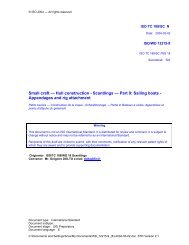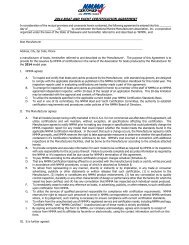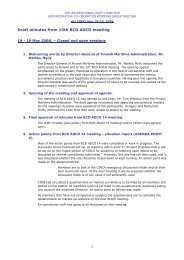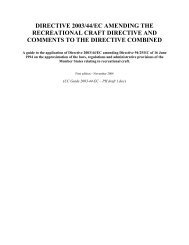global environmental legislation guide - National Marine ...
global environmental legislation guide - National Marine ...
global environmental legislation guide - National Marine ...
You also want an ePaper? Increase the reach of your titles
YUMPU automatically turns print PDFs into web optimized ePapers that Google loves.
pollution (sulphur dioxide, nitrogen oxides, volatile organic compounds (VOCs) andammonia), but leaves it largely to the member states to decide which measures – on top ofcommunity <strong>legislation</strong> for specific source categories - to take in order to comply. The NECDirective has been amended as part of the accession of new EU member states. Aconsolidated NEC includes the entire community as of 1 January 2007.Parallel to the development of the EU NEC Directive, the EU member states alongside theCentral and Eastern European countries, the United States and Canada have negotiated the"multi-pollutant" protocol under the convention on long-range trans-boundary air pollution(the so-called Gothenburg protocol, agreed in November 1999). The emission ceilings in theprotocol are equal or less ambitious than those in the NEC Directive.EU Emission ceilings for 2010 (SO2, NOx and VOC)• SO2 - 7 832 Kilotonnes• NOx - 8 180 Kilotonnes• VOC - 7 585 Kilotonnes: 15% of total VOC emission applies to coating activitiesIssues for the recreational marine and superyacht industriesShould individual member states fail to achieve their NEC targets, they will be required totake additional measures in order to achieve them. Consequently it is possible that a facilitythat is meeting the SED/IPPC requirements may be directed by their national/regionalauthorities to further reduce their emissions to meet the national targets.Update:According to the European Community Directive 2001/81/EC (NEC directive), member stateshad to reduce their emissions of certain atmospheric pollutants under national emissionceilings by 2010. The emission ceilings are fixed for four pollutants (ammonia, nitrogenoxides, sulphur dioxide and volatile organic compounds) for each member state and for theEuropean Union as a whole. The main objective of the directive was to improve theprotection of the environment and human health against risks of adverse effects fromeutrophication, acidification and ground level ozone.Member states were obliged to report annually on emissions and emission projections until2010. In addition to this, in 2002 and 2006 they had to establish a national program detailingthe planned measures in order to reach the ceilings.The commission has decided to link this report to the preparation of the thematic strategyon air pollution, presented in the 6 th Environmental Action Programme 1. In order to gatherrelevant scientific information with a view to propose this thematic strategy, the commissionlaunched the Clean Air for Europe (CAFE) program 2 (See IED and PPD).Comparison of emissions and projected emissions with the NECD emission ceilings for2010All member states submitted emission data and provided projection data required by thedirective in the latest (2009) reporting to the commission in 2010. Fourteen member statesanticipated they would meet all four of the pollutant-specific emission ceilings specified inthe NECD, with the remaining thirteen member states indicating that they would miss at12











